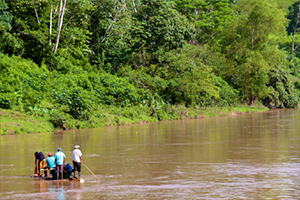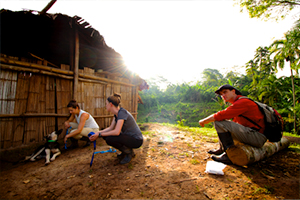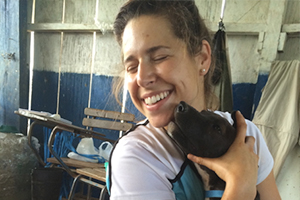


Last year I was lucky enough to join a project with Dr. Christine Fiorello of the One Health Institute, who was working with anthropologist Jeremy Koster of the University of Cincinnati. As part of his research on domestic hunting dogs owned by subsistence farmers in the Bosawás Biosphere Reserve in the rainforest of northern Nicaragua, Dr. Koster needed a baseline health status of these dogs. Dr. Fiorello, fellow vet student, James Liu (class of 2015), and I, traveled during the summer of 2013 to the Bosawás Reserve for a pilot attempt at data collection. We succeeded in performing physical exams, taking biological samples (blood and urine), and interviewing owners. We were especially interested in assessing disease prevalence of muli-host pathogens such as Leptosipira, which could potentially affect other domestic animals, sensitive wildlife, and humans. Laboratory analysis gave evidence that leptospirosis exists in the area, in addition to confirming a very high prevalence of exposure to canine viruses and tick-borne disease.
Following this successful pilot study, we recruited two more vet students, and returned this past summer into the indigenous communities of the Bosawás Reserve. While anticipating my return this summer, I was calmed by the thought that I had been there before, I knew what to expect, and everything should go smoothly. I had no reason to expect otherwise, as we could only consider ourselves seasoned experts at navigating the foreign landscape, water-laden lands of the reserve. That’s the strange and wonderful thing about travel, you simply can never anticipate how it will play out.
We had a solid plan to stay and work in one large community for three weeks. It was not even three days in that we realized that we were sure to hit some roadblocks. To name a few, we got kicked out of our accommodation by the mean-spirited town policeman, the number of folks who brought us dogs to examine quickly dwindled after a few days, leaving us twiddling our thumbs for hours on end, and community helpers who Dr. Koster had planned to work with through the year proved themselves incapable of following through on his tasks. Taking this all in stride, we made a new plan, all the while navigating sudden downpours, lack of electricity to spin our blood samples, attacks by incessant mosquitos and biting midges, and bouts of malaise within the muddy landscape of the Nicaraguan rainforest.
Despite these challenges, we reached our goal of examining 200 dogs by the end of three weeks! Not only did this feel like a phenomenal accomplishment at the time, I know I gained much more than solidifying clinical skills of venipuncture, physical exams, and cystocentesis. We had come together as a team, leaned on each other through moments of doubt, unbearable itchiness, and homesickness, and come out having learned yet another lesson on the importance of flexibility. Adjusting plans and navigating surprises will always be critical for successful fieldwork, but perhaps more importantly, will be an integral part of veterinary medicine regardless of our career paths.
International Programs funding has provided me the opportunity to solidify fundamental skills, gain life-long friendships, and travel to an incredibly unique location. I have experienced an entirely new perspective on life, where our creature comforts like running water and electricity don’t exist. The most valuable lesson I have learned over the last two summers of travel is that happiness can still be found in the simple pleasures of family and community. Thank you International Programs for helping to expand my horizons!
To read more about the hunting dogs in the Bosawas Biosphere Reserve, Laura included a link to the story about Amanda Campbell who worked with Laura and Dr. Christine Fiorello in Nicaragua.
